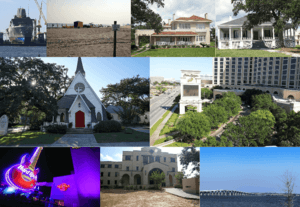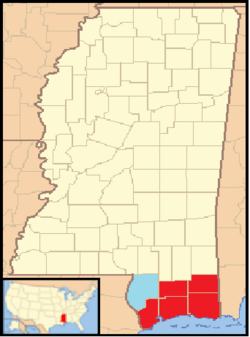Mississippi Gulf Coast facts for kids
Quick facts for kids
Mississippi Gulf Coast
|
|
|---|---|
|
Region
|
|

Clockwise from top: Ingalls Shipbuilding, the Biloxi Beach, the Dantzler House, Beauvoir, the Beau Rivage Casino, the Bay Saint Louis Bridge, the USM Gulf Park, the Hard Rock Casino Biloxi, and Saint John's Epispocal Church
|
|
| Nickname(s):
The Coast
|
|

Map of Mississippi with the Gulf Coast region highlighted. The counties in red correspond to the Gulfport-Biloxi-Pascagoula MSA. Pearl River County (blue) is included in the geographical definition which includes all of Mississippi south of 31° N.
|
|
| Area | |
| • Total | 2,764,358 acre (1,118,696 ha) |
| Dimensions | |
| • Length | 80 mi (130 km) |
| • Width | 55 mi (89 km) |
| Population
(April 1, 2010)
|
|
| • Total | 370,702 |
| • Estimate
(2018)
|
397,261 |
| Time zone | UTC-6 (CST) |
| • Summer (DST) | UTC-5 (CDT) |
| Area code(s) | 228 |
The Mississippi Gulf Coast is a special area in Mississippi. It sits along the Mississippi Sound, which is part of the huge Gulf of Mexico. People also call it the Mississippi Coast or simply The Coast.
Contents
Exploring the Mississippi Gulf Coast
This region is made up of several counties. When Mississippi first became a state, only Hancock and Jackson counties were part of this area. Over time, new counties were formed. These include Harrison, Pearl River, Stone, and George counties.
Cities of the Coast
Many cities on the Mississippi Gulf Coast are right on the water. The U.S. Census Bureau groups these cities into special areas. The main area includes Hancock, Harrison, and Jackson counties. Two more counties, George and Stone, were added later.
Some of the cities you can find here are:
- Biloxi
- Ocean Springs
- Waveland
- Bay St. Louis
- Diamondhead
- Pass Christian
- Long Beach
- Gulfport
- D'Iberville
- Gautier
- Pascagoula
- Moss Point
- Lucedale
- Wiggins
History of the Mississippi Gulf Coast
The Mississippi Gulf Coast has a long and interesting history. Many different groups of people have lived here over hundreds of years.
Early Native American Life
The Biloxi people were living in this region a very long time ago. They were here at least as early as 1699.
Colonial Times
In 1699, a French explorer named Pierre Le Moyne d'Iberville came to the area. He wanted to start a French colony near the mouth of the Mississippi River. He first landed on Ship Island. A few days later, he arrived on the Mississippi Gulf Coast.
D'Iberville and his group built Fort Maurepas. This fort became the first capital of French Louisiana. It was a base for exploring the surrounding lands. However, the French settlers found it hard to live there. They faced problems like crops dying and not enough fresh water. Because of these difficulties, the capital of French Louisiana moved to Mobile in 1701. The fort was left empty by 1702.
Later, the capital moved back to Biloxi for a short time. This was while the city of New Orleans was being built. But the earlier problems meant the Gulf Coast did not play a big role in French plans.
Mississippi Becomes a State
Mississippi joined the United States in 1817. At that time, most people in the state lived in the northern parts. Only a small number of people lived on the coast. The coastal areas were still like a frontier. They had cultural influences from places around the Mediterranean Sea.
According to Kenneth P'Pool, a history expert, the coast's location on the Gulf of Mexico helped it connect with the rest of the world. This was easier than for other parts of Mississippi.
The Civil War and Beyond
During the American Civil War, Fort Massachusetts on Ship Island was taken over.
In the 1900s, Keesler Air Force Base helped the region grow. But the coast also faced big challenges. Two very strong storms, Hurricane Camille in 1969 and Hurricane Katrina in 2005, caused huge damage.
The Mississippi Gulf Coast was once called "America's Riviera." In the early 1900s, it became a popular place for tourists. People came for fun activities and even some gambling, which was allowed at certain resorts. It also had the longest man-made beach in the world. Golfing was another big attraction. People who lived in colder places came to play golf all year.
In the early 1990s, gambling became legal in Harrison and Hancock counties. This led to a new period of growth. Many large hotels and casinos, like those in Las Vegas, were built. Condo towers also started to appear along the coast. The area became the second largest gaming area in the U.S. based on the size of its casinos. After Hurricane Katrina, the Mississippi Gulf Coast recovered quickly, even faster than New Orleans.
Learning and Education
The Mississippi Gulf Coast has many schools for kids of all ages. As of May 2019, there were 126 schools for students from kindergarten to 12th grade. These schools are part of 16 different school districts.
There are also colleges for older students:
- Mississippi Gulf Coast Community College offers two-year degrees and job training programs.
- The University of Southern Mississippi has a campus in Long Beach. It offers bachelor's and master's degrees.
- In 2009, William Carey University opened its Tradition campus. It offers many different study programs.
Here is a list of school districts and their achievement ratings:
| District | Achievement Rating | Number of Schools |
|---|---|---|
| Harrison County School District | B | 20 |
| Hancock County School District | B | 6 |
| Pearl River County School District | B | 4 |
| George County School District | B | 8 |
| Stone County School District | B | 4 |
| Jackson County School District | B | 13 |
| Gulfport School District | B | 10 |
| Biloxi Public School District | A | 8 |
| Ocean Springs School District | A | 6 |
| Picayune School District | C | 9 |
| Pascagoula-Gautier School District | B | 17 |
| Bay St. Louis-Waveland School District | C | 4 |
| Long Beach School District | A | 5 |
| Pass Christian Public School District | A | 4 |
| Poplarville School District | A | 4 |
| Moss Point Separate School District | D | 4 |
Famous People from the Coast
Many well-known people have come from the Mississippi Gulf Coast.
- Mahmoud Abdul-Rauf, former NBA player
- Jeramey Anderson, American politician
- Walter Inglis Anderson, painter, writer, and naturalist
- Frederick Barthelme, novelist
- Manly Barton, American politician
- William Joel Blass, American politician
- Milt Bolling, American baseball player
- John Bond Jr., American politician
- Devin Booker, NBA shooting guard
- Charles Busby, American politician
- Cyril Edward Cain, American educator and historian
- Joseph Hilliard Cain Sr., American politician
- Joel Carter, American politician
- Carolyn Crawford, American politician
- Varina Davis, First Lady of the Confederate States of America
- Scott DeLano, American politician
- Jeremy England, American politician
- Casey Eure, American politician
- Mike Ezell, American politician
- Brett Favre, NFL quarterback
- Kevin Felsher, American politician
- Boyce Holleman, American politician
- Jeffrey Hulum III, American politician
- Prentiss Ingraham, soldier and writer
- Eugene Antonio Marino, Archbishop
- George Austin McHenry, Mississippi pioneer and physician
- Jay McKnight, American politician
- Stevon Moore, American football player
- Jack Nelson, Pulitzer Prize winning journalist
- George E. Ohr, ceramic artist
- Steven Palazzo, American politician
- John Read, American politician
- Brittney Reese, Olympic long jumper
- Robin Roberts, ABC News anchor
- Mike Seymour, American politician
- Larkin I. Smith, American politician
- Gene Taylor, American politician
- Mike Thompson, American politician
- Jesmyn Ward, American writer
- Brice Wiggins, American politician
- Fannie C. Williams, American educator
- William Woodward, American artist


